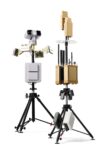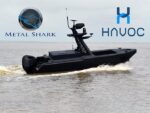Rocket Lab has successfully launched the first of up to 21 dedicated missions for Japanese synthetic aperture radar (SAR) satellite operator Synspective. The mission marks a significant milestone in commercial space-based ISR (intelligence, surveillance, reconnaissance) capabilities and highlights the growing role of small launch vehicles in supporting persistent Earth observation networks.
Electron Launch Delivers StriX-3 SAR Satellite into Precise Orbit
The mission—dubbed “The Moon God Awakens”—lifted off from Rocket Lab’s Launch Complex 1 in Mahia Peninsula, New Zealand on March 13 at 22:03 NZDT. It successfully deployed Synspective’s StriX-3 satellite into a Sun-synchronous orbit (SSO), continuing the buildout of a planned constellation of commercial SAR satellites aimed at providing high-resolution imagery regardless of weather or lighting conditions.
StriX-3 is part of Synspective’s broader vision to deploy a constellation of at least 30 satellites by the late 2020s. Each spacecraft is equipped with X-band synthetic aperture radar capable of capturing sub-meter resolution imagery through cloud cover and at night—critical capabilities for defense customers and disaster response agencies alike.
Synspective’s Strategic ISR Ambitions and Dual-Use Potential
Synspective was founded in Tokyo in 2018 with backing from major Japanese investors including the Japan Bank for International Cooperation (JBIC) and Mitsubishi UFJ Capital. Its stated goal is to provide high-frequency SAR data services across Asia-Pacific and globally. While officially marketed as a commercial geospatial intelligence provider focused on infrastructure monitoring and urban planning, Synspective’s constellation has clear dual-use potential.
The company’s satellites offer revisit rates measured in hours rather than days—enabling near-real-time change detection over strategic locations such as ports, airfields or military installations. This makes it attractive not only to civilian users but also defense ministries seeking persistent ISR coverage without relying solely on national assets.
Japan’s Ministry of Defense has increasingly signaled interest in leveraging commercial space-based ISR platforms to augment its own reconnaissance capabilities amid growing regional tensions with China and North Korea. The StriX satellites’ ability to penetrate cloud cover gives them an edge over traditional electro-optical systems during monsoon seasons or inclement weather.
Electron as a Tactical Launch Platform for Responsive Space
Rocket Lab’s Electron rocket continues to demonstrate its value as a tactical launch vehicle tailored for small payload delivery into precise orbits. With this latest success, Rocket Lab has now conducted over 40 launches since its debut in May 2017. Its ability to offer dedicated launches—rather than rideshare slots—gives customers like Synspective control over orbital parameters and launch timing.
- Liftoff mass: ~12.5 metric tons
- Payload capacity: ~300 kg to LEO/SSO
- Stages: Two-stage liquid-fueled + optional third “Kick Stage”
- Propulsion: Rutherford engines using electric pump-fed LOX/RP-1
- Launch cadence: Up to monthly from LC-1 (New Zealand) and LC-2 (Virginia)
The March mission utilized Rocket Lab’s Kick Stage to perform final orbit circularization—a crucial feature when deploying EO/ISR payloads that require tight orbital tolerances for consistent imaging geometry.
A Long-Term Partnership: Up to Twenty-One Dedicated Missions
This launch represents just the beginning of an ambitious multi-launch agreement between Rocket Lab and Synspective signed in December 2020. Under the contract terms—which have since expanded—the two companies plan up to twenty-one dedicated missions through the end of this decade.
The agreement reflects a broader trend toward vertically integrated space ISR ecosystems where satellite operators seek guaranteed access to orbit via tailored launch services rather than relying on opportunistic rideshares aboard larger rockets like SpaceX Falcon or Arianespace Vega-C.
“We’re proud to continue our partnership with Synspective,” said Peter Beck, CEO of Rocket Lab. “By delivering dedicated access to orbit on Electron, we’re enabling them to build out their constellation rapidly while maintaining control over orbital insertion parameters.”
SAR Constellations as Force Multipliers in Modern Conflict Zones
Synthetic aperture radar constellations are increasingly recognized as critical enablers in modern conflict monitoring and crisis response. Their all-weather imaging capability allows analysts to track vehicle movements under camouflage nets or monitor infrastructure damage after missile strikes—even during nighttime operations.
- Tactical ISR: Monitoring troop concentrations or logistics hubs across contested regions like Eastern Europe or the South China Sea
- BDA (Battle Damage Assessment): Evaluating strike effectiveness post-engagement using comparative imagery timelines
- Civil-military fusion: Supporting disaster relief efforts while also informing military situational awareness during hybrid conflicts
The Ukraine conflict has underscored how commercial SAR providers—including ICEYE (Finland), Capella Space (US), Umbra (US), and now potentially Synspective—can complement national intelligence architectures by offering unclassified but tactically relevant data streams accessible by allies or NGOs.
The Road Ahead: Scaling Constellations & Enhancing Revisit Rates
The successful deployment of StriX-3 brings Synspective closer to achieving daily global coverage with revisit intervals under one hour—a key threshold for real-time monitoring applications. Future iterations may incorporate onboard AI processing for anomaly detection or integration with mesh networking architectures that enable crosslink data relay between satellites without ground station reliance.
If realized at scale, this would position Japan as a leading player in resilient space-based ISR alongside U.S., European and Israeli firms—particularly important given Tokyo’s recent moves toward expanded defense posture under revised security policies announced in late FY2022.
Conclusion: Commercial-Security Nexus in Orbit Tightens
The launch marks not just another successful flight for Rocket Lab but also an inflection point where commercial EO/SAR constellations are becoming integral components within national security strategies. As more nations seek persistent situational awareness across multiple domains—from maritime chokepoints to urban megacities—the demand for flexible launch solutions like Electron will likely grow alongside agile satellite operators such as Synspective.










